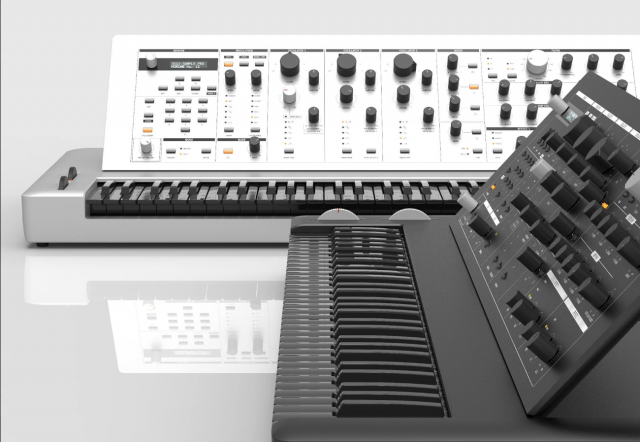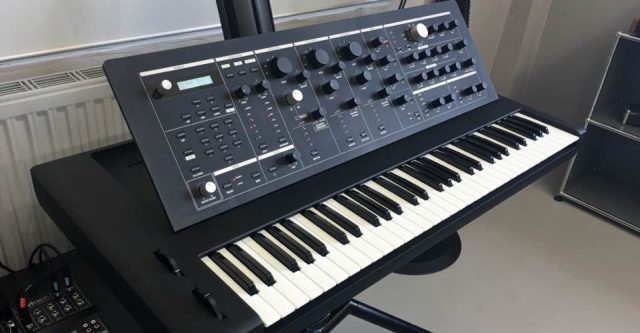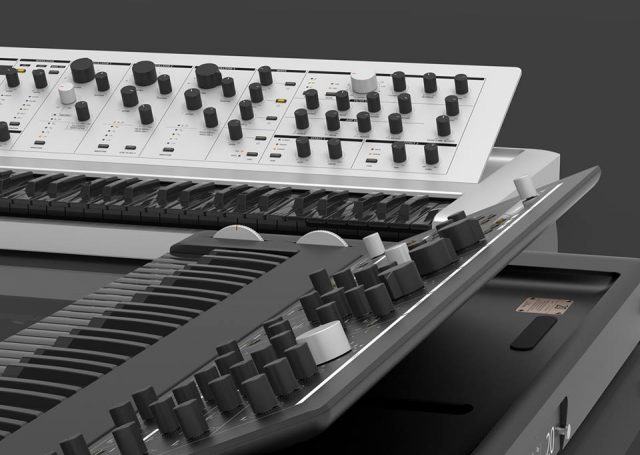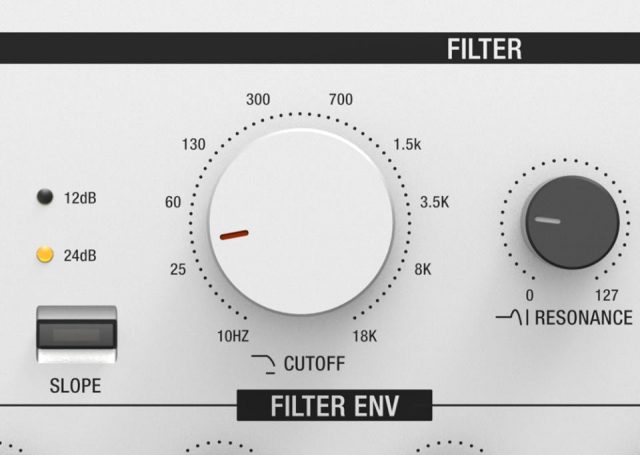
Synth designer Axel Hartmann has announced that his latest design, the 20 Synthesizer, will be shipping at the end of June.

Today he shared this update:
Set up for final testing and sound design. Fatar has sent us a b/w keybed for checking into a modified aftertouch ribbon below the keys, which works perfectly. The final models will be back to an all black keybed.
The Synth you see is the first with black anodized surface. The graphics are laser edged.
I am quite positive, that we can finally release the 20 by the end of June.
The synth is based on a Waldorf synth engine, but is designed to use high-end build quality, including a milled aluminum shell and custom knobs and switches.
The 20 Synthesizer is expected to be available at the end of June for 20,000 Euro. 20 will be made in each finish.





Really does not warrant this price and its comical that its based on a waldorf. They are great synths but this is absurd.
The design is great …….I am old enough to remember the Waldorf wave , that looked great but again just for the wealthy. I have some nice equipment and to be honest most the synth people I kow would laugh at such decadence. We can build great studios for the same price.
But lovely design…………………
Not sure why people get their shorts in a wad because somebody makes a high-end synth design.
It makes sense that these should be out of the price range of hobbyists and amateurs – they are designed for studios and professional musicians.
This belongs in a long tradition of high-end monster synths – CS80, Synclavier, Yamaha VL-1 & DX-1, the Schmidt Polyphonic Synthesizer, Kurzweil K2500 AES, Moog System 55 – that are designed to offer the best that money can buy. You can argue that you can buy 20 synths for the price of a Schmidt or a ’20’ synth – but none of them will be as good.
“It makes sense that these should be out of the price range of hobbyists and amateurs – they are designed for studios and professional musicians.”
never heard bullshit like this before…
Sorry if you can’t handle the facts.
Do you really think that the people buying high-end synths have ever been dudes making music in their bedrooms? Do you think that hobbyists were playing Fairlights and Emulators in their pajamas or something?
There’s an entire world of pro gear that most people never think about.
This is an interesting perspective because it seems to be exactly wrong. As someone who has manufactured and sold high-end audio gear, I can tell you that yes, it is indeed the bedroom musician/collector that often buys the high-end “status” piece. Most studios (I have worked at five and owned one) would purchase the stripped-down “workhorse” version when available. For that matter, most studios don’t buy many/any synths, and when they do, they buy well-known “standards” like a Moog, DSI, Korg, Roland, or Nord.
It’s possible that some “pro” artists would spend the money to get an instrument like this, but that’s usually just because they are gear collectors that also happen to make money from making music – they probably wouldn’t ever want to tour with an instrument like this or use it as their main workstation. I think you might be mistaken about your idea of “pro gear.”
There is quite a difference between a high-end sounding synth and a high-end looking one.
At least if you are in the audio business the first ones should be the ones you would want to buy not the latter.
And to reply to the bedroom joke you are attempting there, look at Legowelt to name one. It’s not how you look it’s how you sound. Unless of course you buy gear to showcase it.
Jarre made Oxygene in his bedroom
As Maurice Jarre composer’s son, he had a big bedroom.;-)
I do not doubt for one second that you have, indeed, not “heard” this at all.
Your argument and defence of this synth is rubbish. I am all for quality and price be damned. This is a re-badging.
There is a lively debate about this on Sonicstate. You have a read.
Since when is people complaining about prices considered ‘lively debate’? There are dweebs that make the same complaint when Korg intros a new volga. lol
Explain why you think this is different than Yamaha making the DX-1 – which was essentially a pro version of the DX-7?
Or the Kurzweil making the K2500 AES – which was the deluxe Kurzweil with top of the line everything?
It’s bizarre how people think that every high-end synth is elitist rubbish and proof that companies have ‘lost their path’, and ignore the 50-year history of companies making high-end synth gear for the pro market.
This is not a ‘re-badging’. This pairs a Waldorf synth – which has always been great synth engine locked into limiting hardware – with top of the line, knob-filled, no-holds-barred hardware. Like Will said – hopefully this will lead to other Waldorf synths that aren’t stingy with the controls!
The answer to anything you said is: 20.000 Euros.
If they had rebuilt the Q+ or something similar and made a super enclosure for it, then that would be great, but that is not what this is.
Your analogy of the DX-1 and DX-7 is flawed. If this is not new technology, but rebadging older tech, then it definitely DOES NOT FIT. The DX-1 came out a couple of years BEFORE the DX-7. In that time, Yamaha was able to shrink the electronics, make it lighter, and lose some bits in the DAC. The DX-1 was 16-bit, the DX-7 was not.
I’m calculating the cost of a single knob… OK, I decided it’s not worthwhile.
I may list at least 10 machines I can buy with a 20K€ budget, including a Sledge and some very nice looking instruments, mabye also designed by Axel too…
Sell one to Donald Trump, man!
Completely disagree. This is for collectors, not for studios and musicians. We don’t care about machined aluminum and all the other nonsense. We would just buy the sledge for $700 and be done with it. Then we can actually use it, wear it out, whatever. We buy instruments to make sound, not to look at, collect, or invest.
Because there are so many collectors that buy synths and put them in glass cases in museums.
Makes complete sense.
Or you can argue that you could buy a studiologic Sledge, which is LITERALLY THE SAME SYNTH for 1/20th the price.
WOW, it really does have the exact same panel as the Sledge. I’m baffled.
Huh? High end design who cares. High end sound is what counts, this is a pig with lipstick.
i bet that 20 DX7, or 40 minilogues, will blow away 1 “monster-synth”
This price keeps also creative people away….besides that…
I rather buy eurorack modules for this money….seriously…and some decent compressor…eq..make a few custom changes and HERE WE ARE 😀
take this synth out of my view…please…
It seems that 20 synth is targeting rich audio idiots….people with money and no imagination – simple as that…
You’ve played it? How does it sound?
Err yes, thank you for letting us know. I am sure you will find 20 Museums who will put your high end quality synth under an extremely well built glass cover.
its a nice design , just because you can’t afford one doesn’t mean you should cry about it. still a nice design.
It looks like a thin piece of metal with a bunch of boring formless knobs, attached to a midi controller….. design? I don’t see any.
If only it could give Waldorf the good idea to put some knobs on the next Blofeld.
All that really matters is how it sounds.
Price is no object for a laser edged Sledge!
like blofeld/sledge
This is a $900 Sledge synth in a bespoke case. There’s nothing exceptional about the sound of this to compare it to a fairlight or CS80. There’s only 20 of each colour, hence the price. It’s fascinating that people are justifying the price tag based on absolutely nothing but an assumption that it will offer something remarkable. This is the synth equivalent to a special edition Ferrari. Same car, but the single figure availability adds 200k to the price.
People going on about “high-end synth design” need to realise this is essentially a £300 VA put in a shiny case.
20.000€ for a Waldorf engine!!!! Jajajajajajajajajajajajajaja
Well, if I win the Euromillions today, why not, right?
But, with that price, such a pity doesn’t have minikeys.
In the end, you’re left with a boutique synth that will never have a large-enough following to warrant the completion of the firmware. And so, you’ll be left with bugs, no support, and a lifetime reading entries on VintageSynth like, “wow..this thing could have been so cool….”
No thanks. I’m out of this stupid game.
All you need now is 20 goobers to buy it. There’s got to be atleast 20 out there right?
Everyone is assuming it’s a digital Waldorf engine, they have analog products too. A polyphonic pulse would be insane.
It´s just a proof of concept. Axel just wanted to show what would be possible if we take state of the art parts no matter of costs . It´s a designers “dream-machine” . Like the Schmidt. Just look at his vita. The man is the king of synth design. Andromeda A6, Neuron Synthesizer, Minimoog Voyager, Access Virus TI. Art has it´s price.
Oh well, another dream that I will not realize. You can’t go Hartmann on a Minilogue budget.
I read that the Hartmann – Neuron was a pain in the ass to use because it was it had too many software bugs.
So it was a one-off failure!
It’s just impossible to progra, like DX7 opaque.
Not entirely correct. The OS is fine. I have three Neurons, 2 production Neurons and the first assembled functional prototype that I purchased from Prosoniq. All three were dead/non functional when I bought them. The major problem with them is motherboard failure due to the “capacitor plague” of the early 2000’s. The motherboards are common Pentium 3 based boards and can easily be replaced. Hartmann had cost overruns and had to hobble the software to run on cheaper hardware then originally envisaged. Hartmann had issues with the manufacturer and fell out, lost control and went belly up. The Neuron is a curiosity, its fun and weird to play with, but not entirely usable.
Good luck to anyone for doing this. Keyboard warriors aren’t their market.
My concerns is that the Neuron was a more interesting synth. Waldorf already make most of this synth. Plus I could also by a CS-80 and a waldorf (got one already) and still have change.
As for the design. Tasteful verging on safe. Can someone explain how I move the pitch and mod wheels at the same time please?
bad design made to look esoteric – the pitch & mod wheels … ugh. Bad layout, as though the designer had never actually played a Minimoog ever ..
You have no idea how ignorant that comment is.
Hartmann designed the Minimoog Voyager, the Schmidt, the Alesis Andromeda, the Access Virus, etc:
http://www.design-box.de/english/music-electronics/
You can’t ask that price for a synth with a fatar keybed and and a waldorf engine.
I mean what are you selling? the position of the knobs? the color of the case? what?
This is ridiculous.
Surely this is a joke? Surely?!? 20k EURO?!? No no, it’s a joke.
Sorry you can get a knifonium for how much 10k(?) and you get the best sounding synthesizer ever made. But they want you to pay 20k for a Seldge? LOLOLOL!!!
Yes, this thing is absolutely ridiculous from any perspective. It´s not even usable, look at the wheels` placement, made for an alien species? From a design perspective form follows function, so this is not what Hartmann had in mind (like on butt ugly Andromeda). Money-wise it´s a joke and a very bad one. Just a rip-off for ‘money no issue’ people who´d buy anything just for the sake of it and those people really do exist. From a musician´s perspective a joke, too. It´s still just a Sledge which is not bad at what it is but it aint great either. If this thing had polyphonic aftertouch, the fatness in sound of the old greats and decent inbuilt fx it´d be some kind of new flagship. But obviously it´s not that way. Totally ridiculous thing at that price. Make it 2000€, still premium for what it is but more in the ballpark of what it´s actually worth.
If I had a spare 20K, I’d buy it
How much do people think the design and manufacture of only 40 production run units in full brushed aluminum with this quality of finish would actually cost to produce ?
If you had this industrially designed, mocked, up, manufactured and produced in such a small handful of units and had to pay all the manufacturers, fabricators, design team, assembly people etc etc from the ground up they would cost an arm and a leg to recoup investment and cost.
If you could make and guarantee a sale of 100,000 units of more that looked like this the pricing per unit based on volume alone and manufacturing order would drop significantly, if you could guarantee a million selling units it would be even less but we are talking about 20 units in two different styled finishes.
I am not a collector, if I wanted a Sledge I’d buy one and not spend my money on this as it is a bit of a museum piece.
Still, I don’t recall people bitching like this about the price of the new Moog Modular’s or the Gold Plated Voyager that was done in very limited edition a while back.
This was not aimed at the average gigging musician or bedroom studio producer.
So why the fuss and carry on ?
That is a really beautiful synthesizer. Hope he manages to move all 40.
Feel like Korg might owe him a little cash. The mockups for these came out a while before the Minilogue.
Well, they look pretty awesome.. But they sound like a Blofeld? lol. I’ll sell someone my Blofeld if they want it? I’ve never been happy with it’s sound.
Come on now, it always boils down to the same thing..the answer is ” Money”, what was the question?
Deadmau5 will probably buy one, and Craig David. Only 18 to go.
I don’t see anything wrong with a company pricing a product higher than the average hobbyist can afford. Nobody complains about ludicrously expensive supercars. It’s the free market. Quit whining and be happy with what you have.
…you missed the whole point of why people are annoyed and laughing. It’s ‘not’ a supercar! It’s like a kit car. It’s like a ford focus with fancy body.
I would expect at least a high-quality Fatar keybed. On the pictures I see a regular Fatar like the ones you find in a NI Komplete. Fatar has high-quality keybeds. But they cost $300 instead of $60!
Obviously most people would never buy a ripoff like this. But. I’m not mad at this guy. Some people live to buy expensive stuff for no reason. The why is because people will pay for it. The why not is because from a practical standpoint it makes no sense whatsoever.
Laser etching and aluminum isn’t that expensive.
Young person +bedroom + £50 worth of apps on laptop = creativity. 20 Synth + a proud owner = no creativity.
Terrible stereotyping. Listen to the sadly recently departed Tomita. Listen to his first album from 1974 and analyse the sounds on it, then compare these to the other synth sounds around at the time and you will hear a level of programming nuance unparalleled. He was a musician with an expensive synth. I can run through many other examples.
Creativity isn’t decided by age or wealth. There can be different triggers for creativity (relative poverty breading a DIY ethic etc) but you can’t call it as clearly as you are trying to.
At $500ish a voice I thought I was paying for luxury when I bought my Elektron Keys.